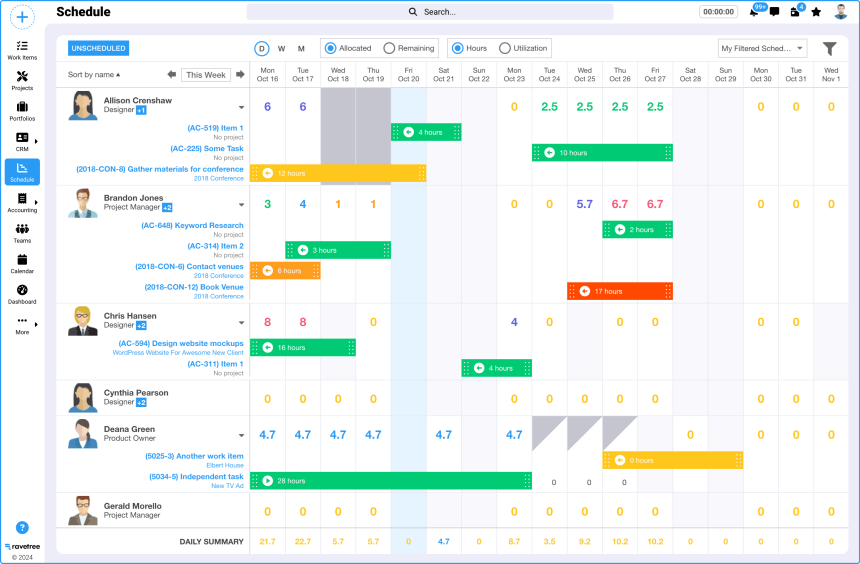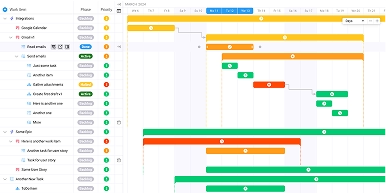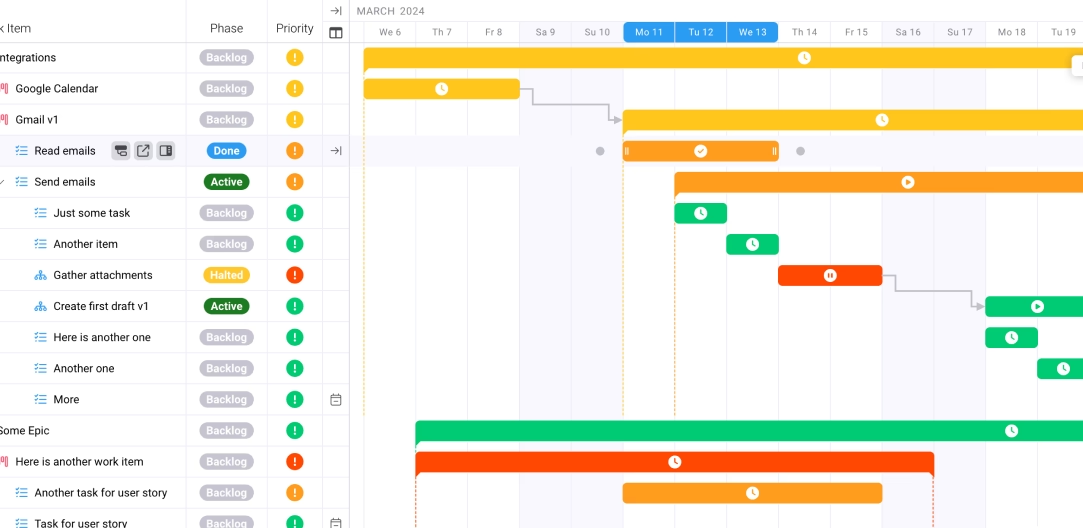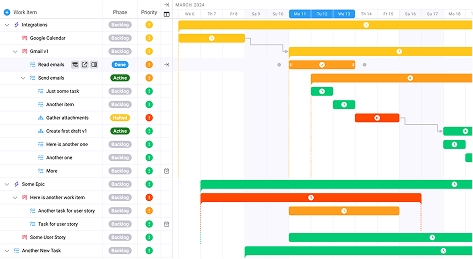
How Project Managers Can Effectively Manage Project Deliverables: A Complete Guide
Key takeaways:
In today’s competitive business landscape, understanding how project managers can effectively manage project deliverables has become crucial for organizational success. Project deliverables serve as the tangible proof of project progress and ultimate success, representing the specific outputs, products, or results that teams must produce to meet stakeholder expectations and business objectives. With organizations reporting that clear project deliverables can help teams hit their project objectives more consistently [1], mastering deliverable management is no longer optional—it’s essential for project success.
Project deliverables encompass everything from detailed reports and software applications to marketing campaigns and physical products. These outputs serve as the bridge between project planning and tangible business value, making their effective management a critical competency for modern project managers. Research indicates that organizations with structured project management practices achieve a 92% success rate in meeting project objectives [2], largely due to their systematic approach to deliverable planning and execution.
Understanding Project Deliverables: Foundation for Success
Defining Project Deliverables
Project deliverables are the tangible or intangible outputs of a project – such as reports, designs, code, marketing assets, and the final product [3]. These outputs represent specific work products that project teams must create, develop, or produce to fulfill project requirements and stakeholder expectations. Unlike project milestones, which mark significant points in time, deliverables are the actual products or services that demonstrate project progress and value creation.
The Project Management Institute (PMI) emphasizes that project management is the application of knowledge, skills, tools, and techniques to project activities to meet project requirements [4]. Within this framework, deliverables serve as the concrete manifestation of successful project execution, providing measurable evidence of team performance and value delivery.
Types of Project Deliverables
Project deliverables typically fall into several distinct categories, each serving specific purposes within the project lifecycle:
Internal Deliverables are work products created for internal project team use and organizational consumption. These include project plans, status reports, risk assessments, and process documentation. Internal deliverables facilitate communication, coordination, and decision-making within the project organization.
External Deliverables represent the final products or services delivered to clients, customers, or external stakeholders. These deliverables directly fulfill project objectives and provide tangible value to end users. Examples include software applications, marketing campaigns, physical products, and professional services.
Process Deliverables encompass the documentation and artifacts created during project execution to support ongoing operations and future projects. These include process documentation, lessons learned reports, and knowledge transfer materials that contribute to organizational learning and capability development.
The Strategic Importance of Deliverable Management
Effective deliverable management directly impacts project success rates and organizational performance. PMI standards provide guidelines for achieving specific project, program, and portfolio management results [5], with deliverable management serving as a cornerstone of these standardized approaches.
Organizations that excel at deliverable management experience several strategic advantages. They demonstrate higher client satisfaction rates through consistent delivery of quality outputs, achieve better resource utilization through structured planning and execution processes, and build stronger stakeholder relationships through transparent communication and reliable performance.
The business impact extends beyond individual project success to encompass broader organizational capabilities. Teams that master deliverable management develop enhanced planning skills, improved risk management capabilities, and stronger collaborative relationships with stakeholders and partners.
Establishing Clear Deliverable Requirements
Stakeholder Engagement and Requirements Gathering
Successful deliverable management begins with comprehensive stakeholder engagement and requirements gathering processes. Clear documentation of project deliverables, requirements, and specifications keeps everyone aligned and provides a reference point for project teams [6]. This alignment prevents misunderstandings, reduces ambiguity, and facilitates effective project execution.
Effective requirements gathering involves multiple stakeholder categories, including project sponsors who provide strategic direction and resource authorization, end users who will ultimately consume or utilize project deliverables, and subject matter experts who contribute specialized knowledge and technical expertise. Each stakeholder group brings unique perspectives and requirements that must be carefully balanced and integrated.
The requirements gathering process should employ multiple methodologies to ensure comprehensive understanding. Structured interviews provide deep insights into stakeholder needs and expectations, while workshops and collaborative sessions facilitate group problem-solving and consensus building. Document analysis helps identify existing requirements and constraints, while prototyping and proof-of-concept development enable validation of complex or ambiguous requirements.
SMART Criteria for Deliverable Definition
Applying SMART criteria (Specific, Measurable, Achievable, Relevant, Time-bound) to deliverable definition ensures clarity and accountability throughout project execution. Research shows that 37% of projects fail due to lack of defined project objectives [7], highlighting the critical importance of precise deliverable specification.
Specific deliverables include detailed descriptions of scope, functionality, and characteristics. Rather than specifying “create a marketing campaign,” specific deliverables might include “develop a multi-channel digital marketing campaign including social media content, email sequences, landing pages, and performance tracking dashboard.”
Measurable criteria enable objective assessment of deliverable completion and quality. These criteria might include quantitative metrics such as response rates, performance benchmarks, or technical specifications, as well as qualitative standards such as brand compliance, user experience requirements, or aesthetic guidelines.
Achievable parameters ensure that deliverable requirements align with available resources, capabilities, and constraints. This includes consideration of team skills, technology limitations, budget constraints, and time availability.
Relevant alignment connects each deliverable to broader project objectives and business value. Teams should clearly articulate how each deliverable contributes to project success and organizational goals.
Time-bound specifications establish clear deadlines and milestone dates for deliverable completion. These timelines should account for dependencies, resource availability, and quality assurance requirements.
Documentation and Communication Standards
Comprehensive documentation serves as the foundation for successful deliverable management throughout the project lifecycle. PMI provides thousands of downloadable deliverables, project plans, presentations, and checklists to help boost project management productivity [8], emphasizing the importance of standardized documentation approaches.
Effective documentation standards include several key components. Deliverable specifications should provide detailed descriptions of scope, requirements, acceptance criteria, and quality standards. Work breakdown structures decompose complex deliverables into manageable work packages, facilitating planning and resource allocation. Responsibility matrices clearly define roles and accountability for deliverable creation, review, and approval.
Communication protocols establish regular touchpoints for deliverable status updates, stakeholder reviews, and issue resolution. These protocols should specify communication frequency, formats, and escalation procedures to ensure that stakeholders remain informed and engaged throughout deliverable development.
Version control and change management procedures ensure that deliverable requirements remain current and that modifications are properly documented and communicated. These procedures become particularly important in complex projects with multiple stakeholders and evolving requirements.
Planning and Scheduling Deliverables
Work Breakdown Structure Development
The Work Breakdown Structure (WBS) represents one of the most critical tools for effective deliverable planning and management. Organizations that use project management practices have a 92% success rate in meeting project objectives [9], with structured WBS development serving as a key success factor.
WBS development begins with identification of major project deliverables and their decomposition into progressively smaller, more manageable components. This hierarchical breakdown continues until work packages reach an appropriate level of detail for planning, estimation, and assignment purposes. The optimal level of decomposition typically results in work packages requiring 8-80 hours of effort, enabling accurate estimation while maintaining manageable complexity.
Each WBS element should correspond to a specific deliverable or deliverable component, with clear boundaries and definitions. The structure should be comprehensive, covering all project work, mutually exclusive to prevent overlap and confusion, and organized logically to facilitate understanding and communication.
Effective WBS development involves cross-functional team collaboration to ensure comprehensive coverage and accurate decomposition. Subject matter experts contribute specialized knowledge about deliverable requirements and complexity, while experienced project team members provide insights into realistic work package sizing and dependencies.
Dependency Management and Critical Path Analysis
Complex projects typically involve intricate relationships between deliverables, requiring sophisticated dependency management and critical path analysis. 85% of project managers tend to run multiple projects at the same time [10], making dependency management skills essential for project success.
Dependency types include finish-to-start relationships where one deliverable must be completed before another can begin, start-to-start relationships where deliverables can begin simultaneously but maintain ongoing dependencies, finish-to-finish relationships where deliverable completion must be synchronized, and start-to-finish relationships where one deliverable’s start triggers another’s completion.
Critical path analysis identifies the sequence of dependent deliverables that determines overall project duration. Understanding the critical path enables project managers to focus attention and resources on the most time-sensitive deliverables while identifying opportunities for parallel work execution and schedule compression.
Resource constraints often create additional dependencies beyond pure work sequence requirements. Teams must consider resource availability, skill requirements, and capacity limitations when scheduling deliverable development and establishing realistic timelines.
Resource Allocation and Capacity Planning
Effective resource allocation requires comprehensive understanding of deliverable requirements, team capabilities, and organizational constraints. Project management software market growth of 10.67% CAGR [11] reflects increasing organizational investment in tools that support sophisticated resource planning and allocation capabilities.
Resource planning begins with detailed analysis of deliverable requirements, including required skills, effort estimates, and timeline constraints. This analysis should consider both direct labor requirements for deliverable creation and indirect support needs such as review, approval, and coordination activities.
Capacity planning involves assessment of team member availability, considering existing commitments, planned time off, and competing priorities. Organizations must balance deliverable requirements against available capacity while maintaining realistic expectations and sustainable work practices.
Resource optimization strategies include cross-training initiatives to increase flexibility and reduce single points of failure, resource sharing across projects to maximize utilization efficiency, and strategic outsourcing for specialized capabilities or capacity augmentation.

Quality Management and Control
Establishing Quality Standards
Quality management represents a critical component of effective deliverable management, requiring proactive planning and systematic implementation throughout the project lifecycle. Adopting a rigorous approach to deliverable definition, validation and monitoring guarantees not only the quality of the deliverables, but also the success of the project as a whole [12].
Quality standards should be established early in the project planning phase, incorporating stakeholder expectations, industry best practices, and organizational standards. These standards must be specific, measurable, and achievable while maintaining alignment with project objectives and resource constraints.
Comprehensive quality standards address multiple dimensions of deliverable performance. Functional requirements specify what the deliverable must accomplish, while performance standards define how well it must perform. Usability criteria ensure that deliverables meet end-user needs and expectations, while compliance requirements address regulatory, legal, and organizational policy adherence.
Quality planning should also establish clear roles and responsibilities for quality assurance activities, including review processes, approval workflows, and corrective action procedures. These plans must balance thoroughness with efficiency, ensuring adequate quality control without creating unnecessary delays or resource consumption.
Review and Approval Processes
Structured review and approval processes ensure that deliverables meet established quality standards before release or implementation. Clear project deliverables can help teams hit their project objectives [1] when supported by systematic review processes that validate deliverable quality and completeness.
Effective review processes typically involve multiple stages and stakeholder groups. Technical reviews focus on functional requirements, technical specifications, and implementation quality. Business reviews assess alignment with strategic objectives, user needs, and business value creation. Administrative reviews ensure compliance with organizational policies, procedures, and regulatory requirements.
Review criteria should be established in advance and communicated clearly to all participants. These criteria should include specific checkpoints, evaluation standards, and decision-making authorities. Documentation of review results and decision rationale supports transparency and provides valuable feedback for continuous improvement.
Approval workflows must balance thoroughness with efficiency, ensuring adequate oversight without creating unnecessary bottlenecks. Organizations should establish clear escalation procedures for resolving conflicts or addressing issues that arise during review processes.
Continuous Improvement Integration
Quality management should incorporate continuous improvement principles that enable teams to enhance deliverable quality and process efficiency over time. This approach involves systematic collection and analysis of quality data, identification of improvement opportunities, and implementation of corrective and preventive actions.
Quality metrics should be established for each deliverable category, enabling objective assessment of performance trends and improvement opportunities. These metrics might include defect rates, rework frequency, stakeholder satisfaction scores, and adherence to schedule and budget constraints.
Regular quality reviews provide opportunities for team reflection and learning. These reviews should examine both successful practices that should be replicated and challenges that require process improvements or additional training and support.
Knowledge capture and sharing mechanisms ensure that quality improvements benefit future projects and contribute to organizational learning. This includes documentation of lessons learned, best practice development, and training program updates that incorporate new knowledge and capabilities.
Technology and Tools for Deliverable Management
Project Management Software Solutions
Modern project management software, such as Ravetree, Asana, and ClickUp, provides sophisticated capabilities for deliverable planning, tracking, and management. The global project management software market is expected to grow at a CAGR of 10.67% [11], reflecting increasing organizational recognition of these tools’ value for deliverable management and overall project success.
Comprehensive project management platforms integrate multiple functional areas essential for effective deliverable management. Task management capabilities enable detailed work breakdown and assignment, while scheduling tools support timeline development and dependency management. Resource management features facilitate capacity planning and allocation, while collaboration tools support team communication and coordination.
Advanced platforms provide specialized deliverable management features including deliverable templates and standards that ensure consistency across projects, automated workflow capabilities that streamline review and approval processes, and integration capabilities that connect deliverable management with other business systems and processes.
Selection criteria for project management software should consider organizational needs, technical capabilities, and user preferences. Key evaluation factors include functionality alignment with deliverable management requirements, ease of use and adoption potential, integration capabilities with existing systems, and scalability to support organizational growth and changing needs.
Collaboration and Communication Platforms
Effective deliverable management requires robust collaboration and communication capabilities that support distributed teams and stakeholder engagement. 51% of surveyed individuals want to communicate with internal stakeholders via chat apps, like Slack and Microsoft Teams, rather than email [2], indicating strong preference for real-time communication platforms.
Modern collaboration platforms provide multiple communication modalities including instant messaging for quick questions and updates, video conferencing for complex discussions and relationship building, file sharing for deliverable review and collaboration, and project spaces that organize communication around specific deliverables or work streams.
Integration between collaboration platforms and project management systems creates seamless workflows that support efficient deliverable development and review. These integrations enable automatic notification of deliverable status changes, centralized access to deliverable documentation and resources, and streamlined communication workflows that reduce friction and delays.
Platform selection should consider user preferences, technical requirements, and organizational policies. Key factors include communication feature richness and usability, integration capabilities with existing tools and systems, security and compliance requirements, and cost considerations for sustainable implementation.
Automation and AI Integration
Emerging technologies including automation and artificial intelligence offer significant opportunities for enhancing deliverable management efficiency and effectiveness. AI in project management is projected to grow from $3.08 billion in 2024 to $3.58 billion in 2025, with a CAGR of 16.3% [13], indicating substantial investment and innovation in these capabilities.
Automation applications in deliverable management include routine task management such as status updates and reminder notifications, workflow orchestration for review and approval processes, and report generation for stakeholder communication and project tracking. These capabilities reduce administrative overhead while improving consistency and reliability.
AI applications provide more sophisticated capabilities including predictive analytics for timeline and resource planning, intelligent content analysis for quality assurance and compliance checking, and recommendation engines for process optimization and decision support. These capabilities enhance human decision-making rather than replacing human judgment.
Implementation strategies should focus on gradual adoption and integration with existing processes and systems. Organizations should begin with simple automation opportunities that provide clear benefits and low implementation risk, gradually expanding to more sophisticated AI applications as capabilities and comfort levels increase.
Risk Management for Deliverables
Common Deliverable Risks and Mitigation Strategies
Deliverable management involves numerous potential risks that can impact project success, timeline adherence, and stakeholder satisfaction. Proactive risk identification and mitigation planning represent essential components of effective deliverable management strategies.
Scope creep represents one of the most common deliverable risks, occurring when stakeholder expectations or requirements expand beyond original specifications. Mitigation strategies include establishing clear change control processes, maintaining regular stakeholder communication to address evolving needs, and implementing formal scope documentation and approval procedures.
Resource constraints can threaten deliverable quality and timeline adherence when team members become unavailable or overcommitted. Risk mitigation approaches include developing resource contingency plans, cross-training team members to reduce single points of failure, and maintaining relationships with external resources for capacity augmentation when needed.
Technical challenges may emerge during deliverable development, particularly for innovative or complex outputs. Mitigation strategies include conducting feasibility studies and proof-of-concept development, engaging subject matter experts early in the planning process, and maintaining flexible approaches that accommodate technical discoveries and adjustments.
Stakeholder alignment issues can create deliverable rejection or extensive rework requirements when expectations are not properly managed. Prevention approaches include regular stakeholder engagement and feedback collection, prototype development and validation processes, and clear communication protocols for managing changing requirements.
Contingency Planning and Buffer Management
Effective risk management requires comprehensive contingency planning that addresses potential disruptions to deliverable development and delivery. These plans should identify specific response strategies for high-probability risks while maintaining flexibility to address unexpected challenges.
Contingency planning begins with thorough risk assessment that considers likelihood and potential impact of various risk scenarios. High-impact, high-probability risks require detailed response plans with pre-identified resources and decision-making authorities. Lower-probability risks may require monitoring protocols and general response frameworks rather than detailed action plans.
Buffer management involves strategic allocation of time and resource reserves to accommodate unexpected challenges without compromising deliverable quality or overall project success. Schedule buffers should be allocated based on risk assessment and historical performance data, while resource buffers provide capacity to address unexpected requirements or opportunity for accelerated delivery.
Buffer allocation strategies should balance protection against risk with efficient resource utilization. Excessive buffering can lead to resource waste and missed opportunities, while insufficient buffering creates vulnerability to project disruption and stakeholder dissatisfaction.
Quality Assurance Risk Management
Quality risks represent a particularly critical category for deliverable management, as quality defects can require extensive rework, damage stakeholder relationships, and compromise project value delivery. Quality risk management requires proactive identification of potential quality issues and implementation of preventive measures.
Quality risk assessment should consider multiple factors including complexity of deliverable requirements, team experience and capabilities, technology maturity and reliability, and stakeholder expectations and standards. High-complexity deliverables with aggressive timelines typically require enhanced quality assurance measures and contingency planning.
Prevention strategies include comprehensive requirement validation processes, regular quality checkpoints throughout deliverable development, peer review and collaborative quality assurance approaches, and stakeholder engagement in quality validation activities.
Quality contingency planning should address potential scenarios including deliverable rejection by stakeholders, discovery of significant quality defects requiring rework, and resource constraints that might compromise quality assurance activities. These plans should include alternative resource options, escalation procedures, and decision-making frameworks for addressing quality versus timeline trade-offs.
Stakeholder Engagement and Communication
Multi-Stakeholder Communication Strategies
Effective deliverable management requires sophisticated communication strategies that address the diverse needs, preferences, and expectations of multiple stakeholder groups. Each stakeholder category typically has unique information requirements, communication preferences, and decision-making authorities that must be accommodated within overall communication frameworks.
Executive stakeholders typically require high-level summary information focused on strategic alignment, resource utilization, and business value creation. Communication with executives should emphasize outcomes and impacts rather than detailed process information, with clear identification of decisions required and potential implications of various alternatives.
Functional managers need detailed information about resource requirements, timeline implications, and potential impacts on their operational responsibilities. Communication should address coordination requirements, resource availability, and integration with ongoing operational activities.
End users and customers require information about deliverable functionality, timeline expectations, and implementation planning. Communication should focus on value delivery, user experience considerations, and change management requirements.
Project team members need comprehensive information about deliverable requirements, quality standards, timeline expectations, and coordination protocols. Communication should support effective work execution while maintaining alignment with overall project objectives.
Feedback Integration and Expectation Management
Systematic feedback collection and integration processes ensure that deliverable development remains aligned with stakeholder expectations while accommodating reasonable changes and improvements. Clear documentation of project deliverables, requirements, and specifications keeps everyone aligned [6] and provides foundation for effective feedback management.
Feedback collection should employ multiple methodologies and touchpoints throughout the deliverable development process. Regular review meetings provide formal opportunities for structured feedback and decision-making, while informal check-ins enable rapid identification and resolution of emerging issues.
Feedback integration requires careful balance between stakeholder responsiveness and project stability. Changes should be evaluated based on their impact on deliverable quality, timeline implications, resource requirements, and alignment with overall project objectives. Formal change control processes help ensure that feedback integration remains systematic and controlled.
Expectation management involves proactive communication about deliverable capabilities, limitations, and timeline realities. This includes education about technical constraints, resource limitations, and trade-off implications that stakeholders may not fully understand. Regular expectation calibration helps prevent disappointment and maintain positive stakeholder relationships.
Progress Reporting and Transparency
Transparent progress reporting builds stakeholder confidence and enables proactive issue identification and resolution. Effective reporting combines quantitative metrics with qualitative insights to provide comprehensive understanding of deliverable status and trajectory.
Progress metrics should include both completion indicators and quality measures. Quantitative metrics might include percentage completion, milestone achievement, and resource utilization rates. Qualitative indicators might include stakeholder satisfaction ratings, quality assessment results, and risk status evaluations.
Reporting frequency and format should be tailored to stakeholder needs and preferences. Executive stakeholders may prefer monthly dashboard updates with exception reporting for issues requiring attention. Functional managers might require weekly detailed reports with resource and coordination information. Project team members may need daily status updates with task-level detail and immediate issue identification.
Transparency principles should balance openness with appropriate information filtering. Stakeholders should receive information relevant to their roles and responsibilities while avoiding information overload that can reduce communication effectiveness. Issues and challenges should be reported honestly with proposed solutions and support requirements clearly identified.
Performance Monitoring and Measurement
Key Performance Indicators for Deliverables
Comprehensive performance measurement requires carefully selected Key Performance Indicators (KPIs) that provide actionable insights into deliverable management effectiveness and overall project success. These metrics should balance leading indicators that provide early warning of potential issues with lagging indicators that measure ultimate outcomes and value delivery.
Schedule performance indicators measure adherence to planned timelines and milestone achievement. Schedule Performance Index (SPI) provides quantitative assessment of schedule efficiency, while milestone completion rates indicate progress toward major deliverable goals. Trend analysis of schedule performance helps identify patterns and predict future performance.
Quality performance metrics assess deliverable quality and stakeholder satisfaction. Defect rates measure the frequency of quality issues requiring correction, while rework percentages indicate efficiency of initial deliverable development processes. Stakeholder satisfaction scores provide direct feedback on deliverable value and utility.
Resource utilization indicators measure efficiency of resource allocation and utilization. Resource utilization rates indicate whether team members are effectively engaged in productive activities, while cost performance indices measure financial efficiency of deliverable development processes.
Value delivery metrics connect deliverable completion to business outcomes and stakeholder value. These might include user adoption rates, business process improvements, revenue impacts, or other outcome measures that demonstrate deliverable contribution to organizational objectives.
Continuous Improvement Through Data Analysis
Data-driven continuous improvement processes enable teams to enhance deliverable management effectiveness over time through systematic analysis of performance patterns and improvement opportunity identification. This approach requires comprehensive data collection, sophisticated analysis capabilities, and systematic implementation of improvement initiatives.
Performance data analysis should examine multiple dimensions including temporal trends that reveal improvement or degradation patterns over time, comparative analysis that identifies best practices and performance variations across projects or teams, and correlation analysis that reveals relationships between different performance factors.
Root cause analysis helps identify underlying factors that drive performance variations and improvement opportunities. This analysis should consider process factors such as planning adequacy and execution effectiveness, resource factors including skill availability and capacity constraints, and environmental factors such as stakeholder engagement and organizational support.
Improvement initiative prioritization should focus on opportunities with high impact potential and reasonable implementation feasibility. Quick wins that provide immediate benefits while requiring minimal resources can build momentum for more substantial improvement initiatives that may require longer-term commitment and investment.
Benchmarking and Best Practice Development
External benchmarking provides valuable context for performance assessment and improvement opportunity identification. Industry benchmarks help organizations understand their relative performance and identify areas where improvement efforts might yield competitive advantages.
Benchmarking studies should consider multiple performance dimensions and account for contextual factors that might influence performance comparisons. Project complexity, organizational maturity, and resource availability all influence deliverable management performance and should be considered when interpreting benchmark data.
Internal benchmarking across projects and teams helps identify best practices and successful approaches that can be replicated more broadly. High-performing teams and projects provide valuable learning opportunities and sources of proven practices that can enhance overall organizational capability.
Best practice documentation and sharing mechanisms ensure that successful approaches benefit future projects and contribute to organizational learning. This includes process documentation, training material development, and mentoring programs that transfer knowledge and capabilities across teams and projects.
Advanced Strategies and Future Trends
Agile and Hybrid Approaches to Deliverable Management
Traditional deliverable management approaches often prove too rigid for dynamic business environments that require rapid adaptation to changing requirements and market conditions. Agile methodologies provide frameworks for deliverable management that balance structure with flexibility, enabling teams to maintain quality and stakeholder satisfaction while accommodating evolving needs.
Agile deliverable management emphasizes iterative development cycles that produce working deliverable components at regular intervals. This approach enables stakeholder feedback integration throughout the development process rather than waiting for final deliverable completion. Regular demonstrations and reviews provide opportunities for course correction and expectation management.
Hybrid approaches combine traditional planning rigor with agile execution flexibility, particularly valuable for complex projects with both stable and dynamic requirements. Core deliverable specifications and architectures may be established using traditional planning methods, while detailed development and implementation employ agile practices that accommodate learning and adaptation.
Scrum frameworks adapted for deliverable management include sprint planning processes that focus on deliverable component development, daily standups that address deliverable progress and impediments, and retrospectives that capture lessons learned for future deliverable development cycles.
Integration with Business Strategy and Portfolio Management
Advanced deliverable management approaches recognize that individual project deliverables contribute to broader business strategies and portfolio objectives. This integration requires alignment between deliverable specifications and strategic priorities, coordination across related projects and initiatives, and optimization of deliverable development for maximum business value creation.
Strategic alignment assessment evaluates how individual deliverables contribute to organizational objectives and competitive positioning. This analysis helps prioritize deliverable requirements, allocate resources effectively, and make trade-off decisions that maximize strategic value delivery.
Portfolio-level deliverable coordination addresses dependencies and synergies between related projects and initiatives. Shared deliverables, common resources, and integrated timelines require sophisticated coordination mechanisms that transcend individual project boundaries.
Value realization tracking connects deliverable completion to business outcome achievement, enabling organizations to assess return on investment and optimize future deliverable development approaches. This requires sophisticated measurement systems that can attribute business outcomes to specific deliverable contributions.
Emerging Technologies and Innovation Integration
Rapid technological advancement creates both opportunities and challenges for deliverable management. Emerging technologies can enhance deliverable development capabilities while requiring new skills, processes, and management approaches.
Artificial Intelligence and Machine Learning applications in deliverable management include automated quality assurance processes, predictive analytics for timeline and resource planning, and intelligent content generation and optimization. These capabilities can significantly enhance efficiency while requiring new competencies and governance approaches.
Cloud computing and distributed development platforms enable global collaboration and resource optimization for deliverable development. These platforms provide scalable computing resources, collaborative development environments, and integrated tool ecosystems that support efficient deliverable creation and management.
Internet of Things (IoT) and data analytics capabilities create opportunities for enhanced deliverable functionality and value creation. Connected devices and real-time data streams enable new types of deliverables while requiring sophisticated data management and security capabilities.
Blockchain and distributed ledger technologies provide new approaches for deliverable verification, authentication, and value exchange. These technologies may enable new business models and deliverable types while requiring specialized technical capabilities and regulatory compliance approaches.
Technology adoption strategies should balance innovation potential with implementation risk and organizational readiness. Pilot programs and proof-of-concept initiatives enable exploration of new technologies while maintaining stability of existing deliverable development processes.
Industry-Specific Considerations
Software Development and Technology Projects
Software development projects present unique deliverable management challenges related to technical complexity, rapid technology evolution, and user experience requirements. These projects often involve multiple deliverable types including code repositories, documentation, user interfaces, and deployment packages that require specialized management approaches.
Agile development methodologies have become standard practice for software deliverable management, emphasizing iterative development, continuous integration, and stakeholder collaboration. DevOps practices integrate development and operations activities to enable rapid deliverable deployment and continuous improvement.
Technical debt management represents a critical concern for software deliverables, as shortcuts taken during development can create long-term maintenance and enhancement challenges. Deliverable management must balance immediate delivery pressures with long-term sustainability requirements.
Security and compliance considerations require specialized attention in software deliverable management. Security testing, code reviews, and compliance validation must be integrated throughout the development process rather than treated as final verification activities.
Marketing and Creative Projects
Marketing and creative projects involve deliverable types that require subjective evaluation and creative iteration processes. Marketing success hinges on well-defined goals and a clear roadmap [2], particularly when managing creative deliverables that must balance artistic vision with business objectives.
Creative deliverable management must accommodate iterative design processes, subjective feedback integration, and brand consistency requirements. Multiple design iterations and stakeholder reviews are typically required before final deliverable approval.
Brand management considerations require ensuring that all deliverables maintain consistency with organizational brand standards and messaging requirements. This includes visual design elements, content tone and style, and market positioning alignment.
Campaign coordination often involves multiple interconnected deliverables that must be synchronized across channels and touchpoints. Timeline coordination becomes particularly critical when deliverables must launch simultaneously across multiple marketing channels.
Performance measurement for marketing deliverables often requires extended observation periods to assess effectiveness and business impact. Measurement systems must accommodate delayed feedback and attribution challenges inherent in marketing activities.
Construction and Engineering Projects
Construction and engineering projects involve physical deliverables with safety, regulatory, and quality requirements that demand rigorous management approaches. These projects often involve long development cycles, significant resource commitments, and complex stakeholder coordination requirements.
Regulatory compliance represents a critical consideration for construction deliverables, with building codes, safety standards, and environmental regulations creating detailed specification requirements. Compliance validation must be integrated throughout the development process with formal inspection and certification requirements.
Safety management requires specialized attention throughout deliverable development, with worker safety protocols, material handling procedures, and site management practices that must be consistently applied and monitored.
Quality assurance for physical deliverables often requires specialized testing and inspection procedures that may involve third-party certification or government approval processes. These requirements must be planned and scheduled carefully to avoid project delays.
Resource coordination for construction projects involves complex logistics for material delivery, equipment utilization, and workforce scheduling. Weather dependencies and seasonal constraints add additional complexity to deliverable planning and management.
Conclusion
The mastery of how project managers can effectively manage project deliverables represents a fundamental competency that separates successful projects from failed initiatives. Throughout this comprehensive guide, we have explored the multifaceted nature of deliverable management, from foundational planning principles through advanced strategic integration approaches. The evidence consistently demonstrates that organizations investing in structured deliverable management processes achieve significantly higher success rates, better stakeholder satisfaction, and improved business value delivery.
The journey toward deliverable management excellence requires commitment across multiple dimensions. Technical competencies in planning, scheduling, and quality management provide the foundation for systematic execution. Leadership capabilities in stakeholder engagement, communication, and change management enable teams to navigate the human dynamics that ultimately determine project success. Strategic thinking skills help connect individual deliverables to broader business objectives and value creation opportunities.
Technology continues to reshape deliverable management capabilities, with emerging tools and platforms providing unprecedented opportunities for efficiency, collaboration, and insight generation. However, technology serves as an enabler rather than a replacement for fundamental management principles and human judgment. The most successful organizations balance technological capability with human-centered approaches that prioritize relationships, communication, and collaborative problem-solving.
Looking toward the future, deliverable management will continue evolving in response to changing business environments, technological capabilities, and stakeholder expectations. Project managers who commit to continuous learning, embrace emerging technologies thoughtfully, and maintain focus on fundamental success principles will be best positioned to lead their organizations toward sustainable competitive advantages.
The question is no longer whether systematic deliverable management is important—it’s how quickly and effectively organizations can develop these critical capabilities. As the business environment becomes increasingly complex and stakeholder expectations continue rising, understanding how project managers can effectively navigate these challenges is more important than ever before.
References
- Project deliverables: What are they in project management?
- Why Project Management Is Essential for Modern Marketing Teams: Benefits, Tools & Strategies
- What are Project Deliverables? 2025 Management Guide & Examples
- What is project management?
- The Standards Evolution
- How to Define Clear Project Deliverables
- 100+ Project Management Statistics & Facts (Updated 2025)
- Save time with project management templates and tools
- Project Management Statistics: Trends and Common Mistakes in 2024
- 55 Project Management Statistics of 2024
- 95 Essential Project Management Statistics: 2024 Market Share & Data Analysis
- What is a project deliverable? Examples and 5 best practices!
- 110+ project management statistics and trends for 2025









